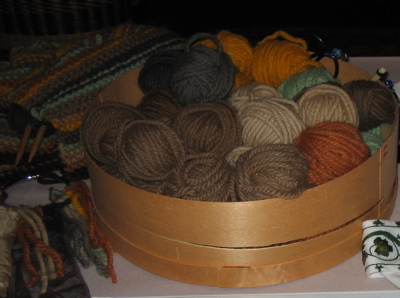
Needlework: |
|
Canvaswork - tent |
|
Pulled Thread (pdf) |
|
Goldwork Basics |
|
Surface Embroidery |
|
Smocking & Pleating (coming soon we hope) |
Clothing: |
Textiles & Thread: |
|
Lucet Basics - Square and Flat Braid |
|
Dyes: |
Cooking: |
Golden Poppy Competition & Entries: |
|
Tinctures: Dyes & Inks |
| Narrow Wares: Fingerloop Braiding (coming soon) |

Take one bag (loosely packed 1 gallon bag) of onion skins. I tried to only get yellow onion skins. Add to 1 gallon of water and boil for 1-2 hours until the water has turned a deep color. Add 7 skeins (each skein approximately 10 yards of Robin and Russ white yarn with a loose twist) of wool. Simmer 4 hours. Remove and rinse well.
One of the problems with onion skins is that you may get a range of color from light yellow to red. This was a red that was very similar to the iron dyed yarn.
4 teaspoons to 1 gallon water. Dissolve well and bring to a boil. Add 8 skeins of yarn (each skein approximately 10 yards of Robin and Russ white yarn with a loose twist). Simmer 30 minutes and turn off heat. Add 3 Tablespoons vinegar to help the color set. Tumeric is very fugitive. Let rest 30 minutes before rinsing well.
Resulting color is a very warm yellow with overtones of orange.
2 gallons water with 2 teaspoons copper, 4 Tablespoons vinegar and 19 skeins wool yarn (each skein approximately 10 yards of Robin and Russ white yarn with a loose twist). Simmer about 30 minutes. The chemical reaction is nearly instanteous, but the simmering helps saturate the yarn. Remove and rinse well.
Resulting color is a wonderful sea green.
Picture: in the background is the tannic acid dyed yarn and the onion skined yarn. Next is another batch of walnut hull dyed skeins. Tumeric dyed yarn in the center with copper dyed yarn front.
Return to the Main Page for Bayrose.org
All Rights to Pictures and Text Reserved by Robin L. Berry, unless noted otherwise - 2007.